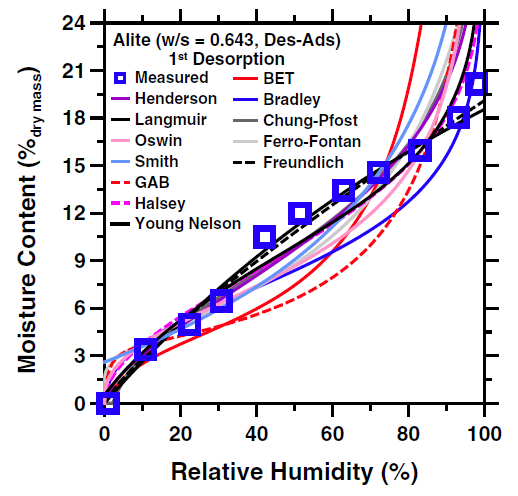 Cement paste is an inherently porous material. Moisture resides within these pores, and the movement of this moisture in and out of the cement paste dictates its durability (i.e. creep, shrinkage, cracking, and transport of corrosive ions). Particularly during the first drying, when cement paste in concrete is exposed to low relative humidities, irreversible changes in pore structure occur. This phenomenon is measured via sorption isotherms, which track the attachement or detachment of single or multiple layers of water molecules from the pore surfaces using weight change at a constant temperature. This research compares sorption data with isotherm models, and develops a means to predict a sorption isotherm using degree of hydration and the initial water-to-solid ratio of the cement paste. Results elucidate the factors contributing to durability problems in cement paste and concrete, and provide an approach to predict beforehand how well or poorly a given cement paste formulation will behave, and how long it will last in the field.
Cement paste is an inherently porous material. Moisture resides within these pores, and the movement of this moisture in and out of the cement paste dictates its durability (i.e. creep, shrinkage, cracking, and transport of corrosive ions). Particularly during the first drying, when cement paste in concrete is exposed to low relative humidities, irreversible changes in pore structure occur. This phenomenon is measured via sorption isotherms, which track the attachement or detachment of single or multiple layers of water molecules from the pore surfaces using weight change at a constant temperature. This research compares sorption data with isotherm models, and develops a means to predict a sorption isotherm using degree of hydration and the initial water-to-solid ratio of the cement paste. Results elucidate the factors contributing to durability problems in cement paste and concrete, and provide an approach to predict beforehand how well or poorly a given cement paste formulation will behave, and how long it will last in the field. Cement paste is an inherently porous material. Moisture resides within these pores, and the movement of this moisture in and out of the cement paste dictates its durability (i.e. creep, shrinkage, cracking, and transport of corrosive ions). Particularly during the first drying, when cement paste in concrete is exposed to low relative humidities, irreversible changes in pore structure occur. This phenomenon is measured via sorption isotherms, which track the attachement or detachment of single or multiple layers of water molecules from the pore surfaces using weight change at a constant temperature. This research compares sorption data with isotherm models, and develops a means to predict a sorption isotherm using degree of hydration and the initial water-to-solid ratio of the cement paste. Results elucidate the factors contributing to durability problems in cement paste and concrete, and provide an approach to predict beforehand how well or poorly a given cement paste formulation will behave, and how long it will last in the field.
Cement paste is an inherently porous material. Moisture resides within these pores, and the movement of this moisture in and out of the cement paste dictates its durability (i.e. creep, shrinkage, cracking, and transport of corrosive ions). Particularly during the first drying, when cement paste in concrete is exposed to low relative humidities, irreversible changes in pore structure occur. This phenomenon is measured via sorption isotherms, which track the attachement or detachment of single or multiple layers of water molecules from the pore surfaces using weight change at a constant temperature. This research compares sorption data with isotherm models, and develops a means to predict a sorption isotherm using degree of hydration and the initial water-to-solid ratio of the cement paste. Results elucidate the factors contributing to durability problems in cement paste and concrete, and provide an approach to predict beforehand how well or poorly a given cement paste formulation will behave, and how long it will last in the field.